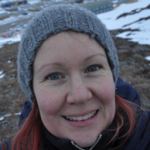Qulliit awards 2 Nunavut women for outstanding work with youth
Eunice Laura Panigayak of Taloyoak and Jukipa Kotiek of Iqaluit recognized this year
This year, Qulliit Nunavut Status of Women Council awarded its Wise Woman award to Eunice Laura Panigayak of Taloyoak, left, pictured with her husband Lenny Panigayak, and its Outstanding Young Woman Award to Jukipa Kotierk of Iqaluit. (Photos courtesy of winners)
Qulliit Nunavut Status of Women Council has recognized two Nunavummiut for their work providing support to youth.
Each year, Qulliit honours women for their outstanding contributions to their communities as volunteers, advocates, leaders and counsellors.
This year, it awarded its Wise Woman award to Eunice Laura Panigayak of Taloyoak and its Outstanding Young Woman Award to Jukipa Kotierk of Iqaluit.
Panigayak, 35, grew up in Naujaat, but moved to Taloyoak 16 years ago, met her husband and stayed.
She’s a counsellor at Netsilik School, where she offers one-on-one and group counselling to students from kindergarten to Grade 8.
“Over the 10 years I’ve been working there, I’ve learned to put on a different hat with every age group,” Panigayak said.
“I deal with a lot of issues of bullying. [They know] that I’m there for them … just being a listening ear and giving some advice if they do need it.”
Outside of school hours, Panigayak coaches volleyball, chairs the Anglican church youth group, teaches Sunday school and volunteers on the local daycare committee.
She does this all while raising her own family: two girls, 10 and 12, and two boys, 7 and 10 months.
“I just love helping people. That’s what I saw growing up, that’s what I know,” she said. “Just being there for youth, basically.”
Panigayak said she’s grateful and honoured to win this year’s award, giving a nod to her husband Lenny for the nomination.
“When I found out it was just one woman a year who wins this, I was shocked,” she said.
Giving space to Iqaluit’s queer community
Outstanding Young Woman Jukipa Kotierk calls Iqaluit home, though their family’s roots are in Igloolik.
Kotierk, who uses the pronouns they and them, was nominated for the award for their work co-founding Ivviulutit, a network for youth who identify as queer and Black, Indigenous or people of colour.
Ivviulutit, which means “to be who you are,” has hosted a number of arts-focused events in Iqaluit since its creation.
“So far, we’ve been trying to amplify and create spaces for Inuit who are part of the queer community, and give them space to use their voices,” said Kotierk.
“So far, a lot of our events have centred around creativity, so that’s been one of our grounding themes.
They note that Ivviulutit is community-driven — it was co-founded with a friend, Jasleen Jawanda.
Kotierk, 26, did an undergrad in Indigenous Studies at Trent University in Ontario, and has worked with the Government of Nunavut’s Qualify of Life Secretariat. They start a new role as child and family advocate with the Umingmak Centre next month.
Since high school, Kotierk said they’ve been drawn to volunteering for different community initiatives, many of them specific to Inuit mental health and wellness: suicide prevention and front-line community services like the soup kitchen and thrift shop.
“I find myself being active in my role as a community member out of the needs I see that aren’t necessarily being met,” they said.
“When I noticed there was an area that wasn’t getting enough attention, we decided to create Ivviulutit.”
Kotierk recognizes the strength and role of Inuit women as the “backbones” of many households. But as an Inuk, they’re also try to open up conversation around a broader gender spectrum.
“Hand in hand, women, non-binary folks, non-gender-conforming folks can all have a place in our communities, and that’s been my understanding of how it’s been in Inuit tradition,” Kotierk said.
“It’s a lot of revitalization, it’s a lot of remembering that Inuit are naturally inclusive of the larger gender spectrum. So it’s just re-opening that conversation and moving away from some western ways of knowing.”







It’s a marvel how progressives (for the lack of a better term) can, with such little self-reflection or insight, co-opt notions of historic socio-cultural truth in support of current intellectual fashions. Though I’m sure they would object to this framing, sincerely believing all the colourful dispersions radiating from their ideological prisms.
To the point, are Inuit really ‘naturally inclusive of the gender spectrum’? I don’t know, but I know a good many who aren’t and have some doubt that this can be called a serious feature of the traditional Inuit way of thinking. I suspect these were not issues that were thought much of at all. Though I admit I’m not an expert, only a skeptic and am open to hearing more.
For their part progressives have solved the problem of criticism on rational, historical or even empirical grounds by reference to a specious, bastardized epistemology they call “other ways of knowing.”
What does that even mean? Again, I’m not sure (good luck finding a good definition) but I love this quote by RationalWiki:
These are “alleged methods of obtaining information by various “alternative” (or non-scientific/non-rational/non-logical) means. Mainly, these exist as an extension of the “non-overlapping magisteria” concept that separates the scientific and physical from the religious or spiritual and as such, allow practitioners of pseudoscience to get away with practically anything.”
And to think, they give awards for this stuff.
One more thought; the primary function of the language, phrases and wordings i’m talking about here is to indicate place in a hierarchy, or social class. That is, they are a speech code used to demonstrate membership in an educated and socially enlightened group which positions itself atop a moral hierarchy.
Something to observe; once these wordings permeate culture and find common usage they will be phased out of use and replaced by a more exclusive set of wordings. Even worse, people who continue to use the older wordings may find themselves castigated for it in public, the older term may even be called a slur, which reinforces the exclusivity of certain terms as well as those who wield them (a good analogy here is of a priesthood—interpreters of divine revelation, how fitting).
Why? There needs to be a measure of scarcity to uphold the value of a particular language currency. This ensures that class lines are clear and visible and most importantly, that those at the top of the heap stay there (or at least replicate their privilege for subsequent generations).
We’ve seen this cycle countless times. Consider the way terms for different racial groups have changed over time. For example, a term that might have found common use in the past like ‘coloured’ which was used to describe African Americans (another term that came and went) is now, by some, called a slur. Yet, the phrase ‘Person of Colour‘ (POC) is used as the most sanctified descriptor ever discovered, delivered from Mt. Sinai.
Odd, isn’t it?
So, the next time you are befuddled at the constantly changing use of terms, and the repudiation of the past use of terms that appear harmless or inert, remember that what you are watching is the replication of class hierarchies and the re-generation of language scarcity to ensure value.